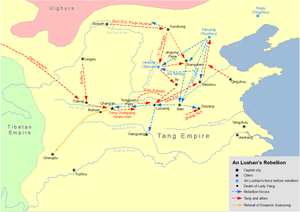
Back ثورة آن لوشان Arabic An Luşan üsyanı Azerbaijani آن لوشان عۆصیانی AZB Rebellion von An Luschan BAR Мяцеж Ань Лушаня Byelorussian Rebel·lió d'An Lushan Catalan Ань Лушань дуьхьалвалар CE Povstání An Lu-šana Czech An-Lushan-Rebellion German Anluŝana ribelo Esperanto
| An Lushan rebellion | |||||||
|---|---|---|---|---|---|---|---|
 Map of military movements during the An Lushan rebellion | |||||||
| |||||||
| Belligerents | |||||||
|
Tang dynasty Uyghur Khaganate Supported by: | Yan dynasty | ||||||
| Commanders and leaders | |||||||
|
Tang Xuanzong # Tang Suzong # Tang Daizong Feng Changqing Gao Xianzhi Geshu Han Guo Ziyi Li Guangbi Zhang Xun Li Siye (DOW) Pugu Huai'en Yu Chao'en Yan Zhenqing Hun Jian Li Baoyu |
An Lushan X An Qingxu Shi Siming X Shi Chaoyi Zhang Xiaozhong Wang Wujun Xue Song Zhang Zhongzhi Li Huaixian Tian Chengsi Tian Shengong (defected) Gao Juren (mutinied and attempted to defect) | ||||||
| Strength | |||||||
| c. 600,000–700,000 at peak | c. 200,000–300,000 at peak | ||||||
| § Death toll | |||||||
| ~13–36 million[a] | |||||||
The An Lushan rebellion was an eight-year civil war (from 755 to 763 AD) during the mid-point of the Tang dynasty that started as a commandery rebellion, attempting to overthrow and replace the Imperial Government with the rogue Yan dynasty. The rebels succeeded in capturing the imperial capital Chang'an after the emperor had fled to Sichuan, but eventually succumbed to internal divisions and counter-attacks by the Tang and their allies. The rebellion spanned the reigns of three Tang emperors (Emperor Xuanzong, Suzong and Daizong).
The rebellion began in the 14th year of the Tianbao era (755 AD). On December 16 (November 9 on the traditional lunisolar calendar), An Lushan, military governor of the Taiyuan Commandery, mobilized his army and marched to Fanyang.[1] An Lushan led the rebellion for two years before he was assassinated by his son An Qingxu. Two years after An Qingxu's ascension, Shi Siming, the governor of Pinglu Commandery and a close ally of An Lushan, killed An Qingxu and usurped the leadership. Shi Siming ruled for two years, but was in turn killed by his own son Shi Chaoyi, who ruled for another two years until the Yan dynasty fell to Tang forces on 17 February, 763 AD.[2] There were also other anti-Tang rebel forces, especially those in An Lushan's base area in Hebei, as well as Sogdian forces and other opportunist parties who took advantages of the chaos. The rebellion is usually known in Chinese historiography as the Ān-Shǐ zhīluàn (simplified Chinese: 安史之乱; traditional Chinese: 安史之亂; lit. 'An-Shi rebellion'), after the two families that led the rebellion, or the Tiānbǎo zhīluàn.
The rebellion was an important turning point in the history of Medieval China, as the military activities and associated combat deaths caused significant population loss from famine, population displacements and large-scale infrastructure destruction, significantly weakening the Tang dynasty, collapsing the prestige of the Tang emperors as the Khan of Heaven and leading to the permanent loss of the Western Regions.[3] Even though the rebellion was ultimately suppressed by a large-scale alliance between the imperial dynasty and various participants, including local militias and foreign support, the dynasty did not overall change the structure of the military committee, but only followed the old principles of establishing territory.[3] It was a direct cause of Tang dynasty's decline, and led to rampant regional warlord secessionism during the latter half of the dynasty that continued into the Five Dynasties and Ten Kingdoms period for decades after Tang's demise. The fear of repeating Tang's commandery secessionism also led the Song dynasty that followed to distrust and oppress prominent military commanders even when invaded by hostile foreign states such as Liao, Western Xia and Jin. It also triggered the long-term decline of the Guanzhong region, which had been a political and economic heartland of China at least since the Han dynasty, and a shift of the economic center of China towards the Jiangnan region.
Cite error: There are <ref group=lower-alpha> tags or {{efn}} templates on this page, but the references will not show without a {{reflist|group=lower-alpha}} template or {{notelist}} template (see the help page).
- ^ John Curtis Perry, Bardwell L. Smith (1976). Essays on Tʻang society: the interplay of social, political and economic forces. Brill Archive. p. 41. ISBN 978-90-04-04761-7.
- ^ Szczepanski, Kallie (2019). What Was the An Lushan Rebellion?. ThoughtCo.
- ^ a b Theobald, Ulrich (12 April 2021). "An Lushan Rebellion 安史之亂". www.chinaknowledge.de. Retrieved 22 March 2024.
© MMXXIII Rich X Search. We shall prevail. All rights reserved. Rich X Search